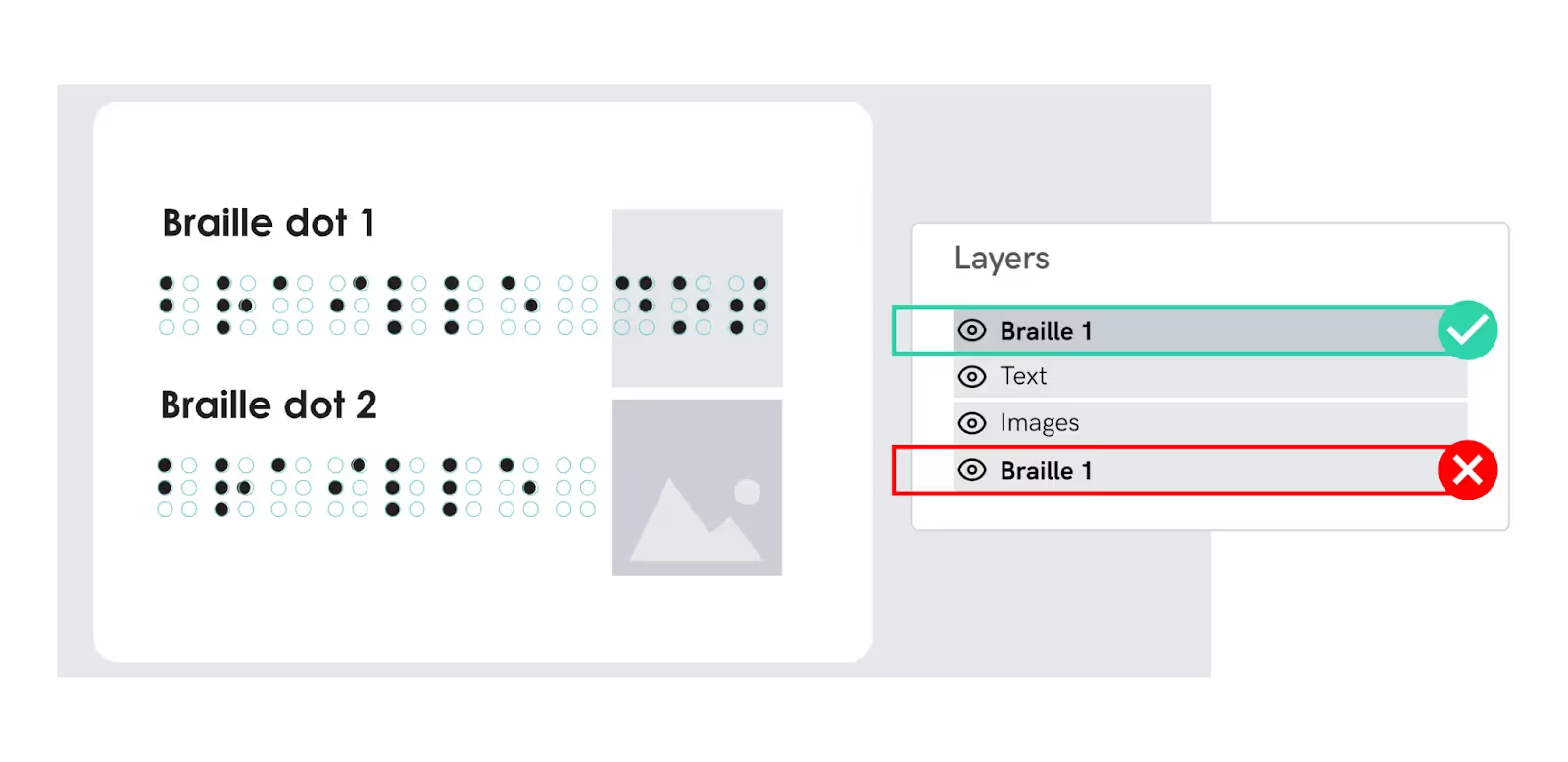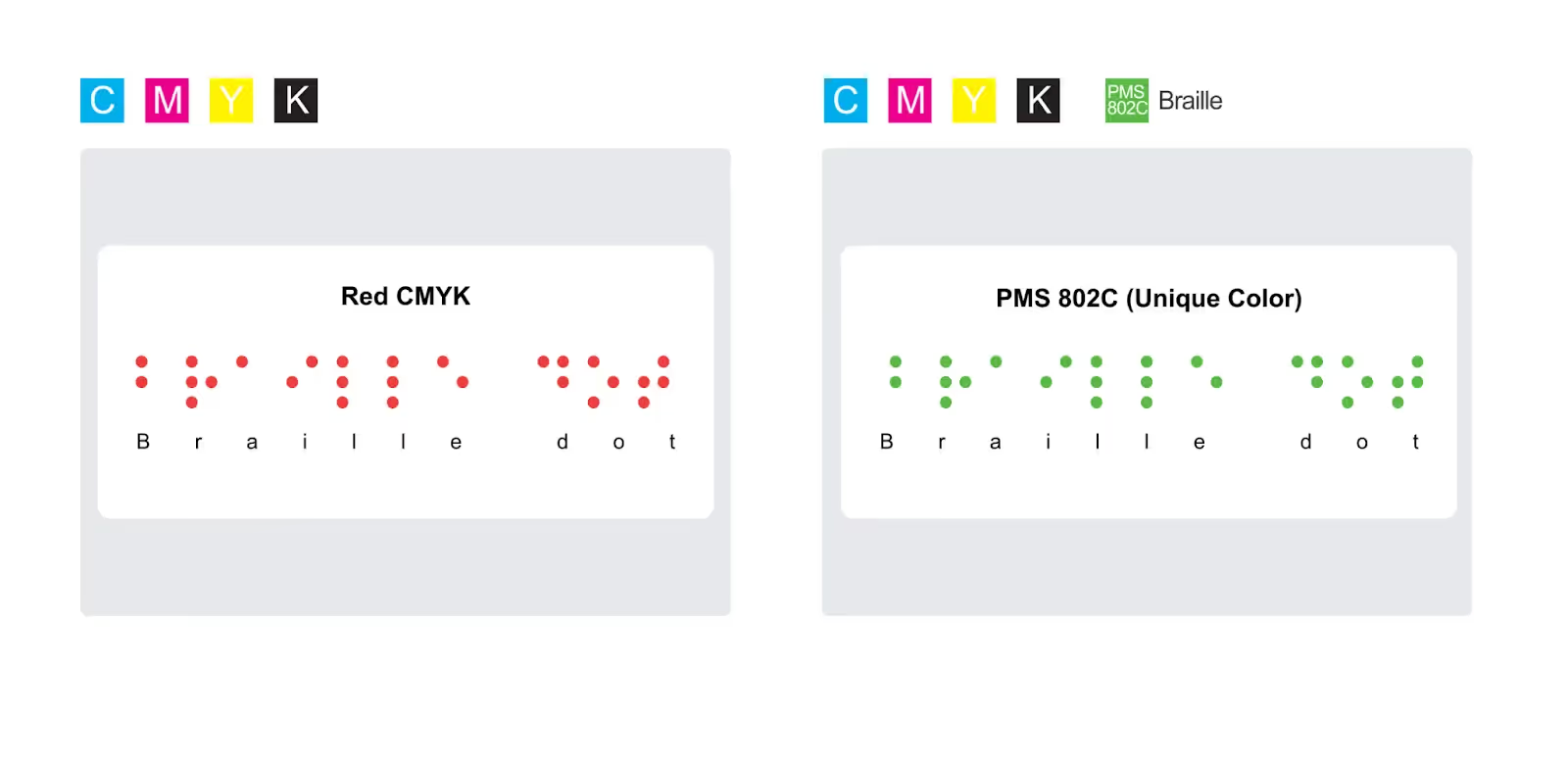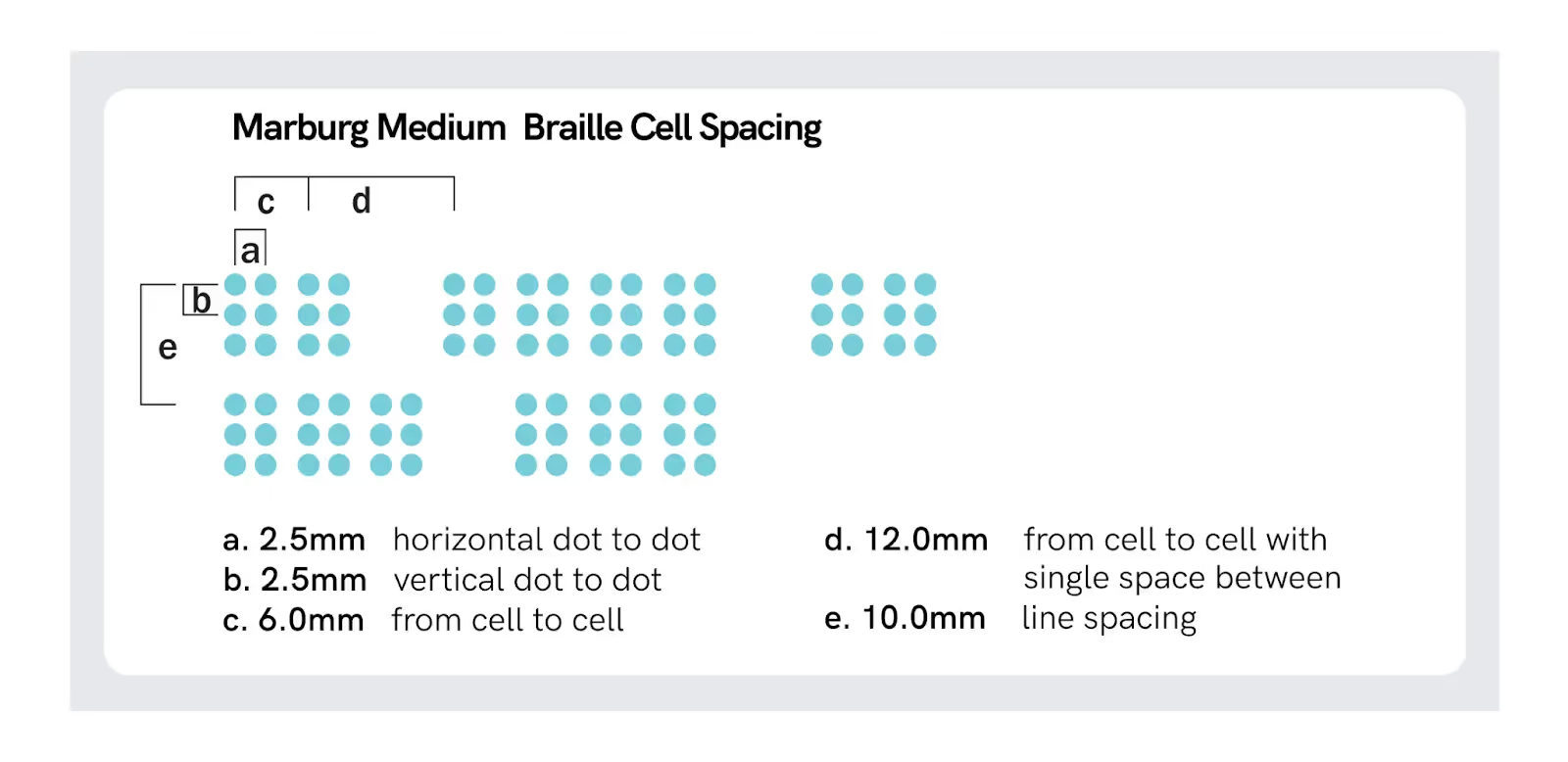Braille
The European Union has mandated that the name of products be included in braille on the packaging of authorized medication to aid in its identification. As part of this initiative, specific requirements have been imposed on the height and placement of braille dots to ensure easy readability for the visually impaired.
The direct consequence of this initiative is that all companies involved in the development of packaging for pharmaceutical products for distribution in Europe need to ensure that their packaging meets compliance standards regarding braille dots. Standardizing the best practices for braille will help ensure that compliance is achieved and maintained.
In this section, GlobalVision describes best practices for creating braille.
Creating a separate top layer for braille
Risk
If you do not create a separate top layer for braille, braille dots may not be detected during the inspection, causing invalid translations.
Issue
Braille dots may be partially or completely hidden by text or artwork.
Example

Solution
Do:
- Create a separate layer containing the braille dots.
- Ensure the braille layer is the top-most layer.
- Use updated versions of Adobe PDF.
Don’t:
- Place braille dots underneath text or artwork.
Tips
The following steps describe how to display existing layers in a PDF:
- Open a PDF in Adobe Acrobat Pro.
- Select Show/Hide from view.
- Select Navigation Panes and click on Layers in the drop-down menu.
- View the layers in the left panel and show/hide their contents.
Creating braille dots with solid-filled fonts
Risk
If you do not create braille dots with solid-filled fonts, braille dots may not be detected during the inspection, causing invalid translations.
Issue
Braille dots that are not solid-filled may overlap or blend in with text, artwork, or die lines.
Example

Solution
Do:
- Create braille dots using PharmaBraille fonts or other standard braille fonts.
- Use updated versions of Adobe PDF.
Don’t:
- Create braille dots that are not solid.
- Draw braille dots.
- Outline braille dots.
Tips
The following options describe how to set up PharmaBraille fonts:
- Set a font size of 10 mm.
- Set the font with a leading (line spacing) of 10 mm (100%).
- See Appendix 06 Braille Cell Dimensions.
NOTE: 10 mm = 28.3465 pt.
Creating PDFs with braille dots of a unique color
Risk
If you do not make braille dots a unique color, the dots may not be detected during the inspection, causing invalid translations.
Issue
Braille dots in a PDF with the same color as the rest of the artwork or text may not be recognized.
Example

Solution
Do:
- Create a separate layer containing braille dots.
- Ensure the braille dots are a unique color.
Don’t:
- Create braille dots that are the same color as the rest of the text or artwork.
Tips
The following steps describe how to create uniquely colored braille dots in Adobe InDesign:
- Choose a new color swatch from the Swatches panel menu.
- Choose the library file from the Color Mode list.
- Select one or more swatches from the library and click Add.
- Go to the braille layers and apply the new color.
Creating braille dots following the Marburg Medium Font Standard
Risk
If you do not follow the Marburg Medium Font Standard, braille dots may not be detected during the inspection causing invalid translations.
Issue
Braille dots that do not follow the Marburg Medium Font Standard for dots, characters, words, and line spacings may not be detected.
Example

Solution
Do:
- Create braille dots that adhere to the Marburg Medium Font Standard.
- Use PharmaBraille fonts or other standard braille fonts.
Don’t:
- Create braille dots that do not adhere to the Marburg Medium Font Standard.
Tips
The following options describe how to set up PharmaBraille fonts:
- Set a font size of 10 mm.
- Set the font with a leading (line spacing) of 10 mm (100%).
- See Appendix 06 Braille Cell Dimensions.
NOTE: 10 mm = 28.3465 pt.
Creating braille dots using a validated standard font
Risk
If you do not use a validated standard font to create braille dots, the dots may not be detected during the inspection, causing invalid translations.
Issue
Braille dots in a PDF created by using a non-standard braille font (perhaps
featuring smaller spaces than are normally accepted) may cause invalid translations.
Example

Solution
Do:
- Create braille dots using PharmaBraille or other standard braille fonts.
- Validate the braille font before using it in the artwork files.
- Use the Marburg braille grid as a template to verify the dot position.
Don’t:
- Create braille with a free font that does not conform to the Marburg Medium
Font Standard.
- Create braille using a font with an anonymous source.
Tips
The following options describe how to set up PharmaBraille Fonts:
- Set a font size of 10 mm.
- Set the font with a leading (line spacing) of 10 mm (100%).
- See Appendix 06 Braille Cell Dimensions.
NOTE: 10 mm = 28.3465 pt.
Ensuring braille reading left to right alignment for all languages
Risk
If you do not ensure the braille reading left to right alignment for all languages in your artwork, unwanted characters may be detected by the proofreading software on the final approved material and may affect the verification of the line space.
Issues
- The proofreading software may detect an invalid translation.
- Extra spaces before the line may corrupt the translation when text is read by the software.
- The braille may be divided into a different region
Example

Solution
Do:
- Left align lines of braille for all languages including Arabic and Hebrew.
- Respect the Marburg medium Standard to set the Line spacing.
- Use a valid grid as a template to verify the dot position.
Don’t:
- Center align the braille in the document.
- Indent braille paragraphs for more than 2 cells.
- Use a dot size smaller than the requested standard.
- Use a blank line between a paragraph in braille.
Tips
See the Grid Example in Appendix 10 (Braille positioning Template).
- Use the PharmaBraille template.
Avoiding using transparency on braille fonts
Risk
If you use transparency on your braille fonts, an erroneous translation may occur when using overprint or transparency.
Issue
Unwanted characters will be detected in the final approved material PDF.
Example

Solution
Do:
- Apply 100% color to braille on artwork.
- Use a unique color for braille on artwork files.
- Add overprint on the braille contents.
Don’t:
- Use transparency on braille fonts.
Tips
The following steps describe how to Check Transparency and Overprint in a PDF:
- Use Adobe Acrobat's Preflight tool to verify transparency.
- Go to "Print Production" > "Preflight," and check for transparency issues in the preflight profiles.
- In Adobe Acrobat, go to “Use Print Production" in Tools > "Output Preview" to toggle the overprint simulation mode.
- This helps visualize how colors interact which is crucial for print accuracy.


